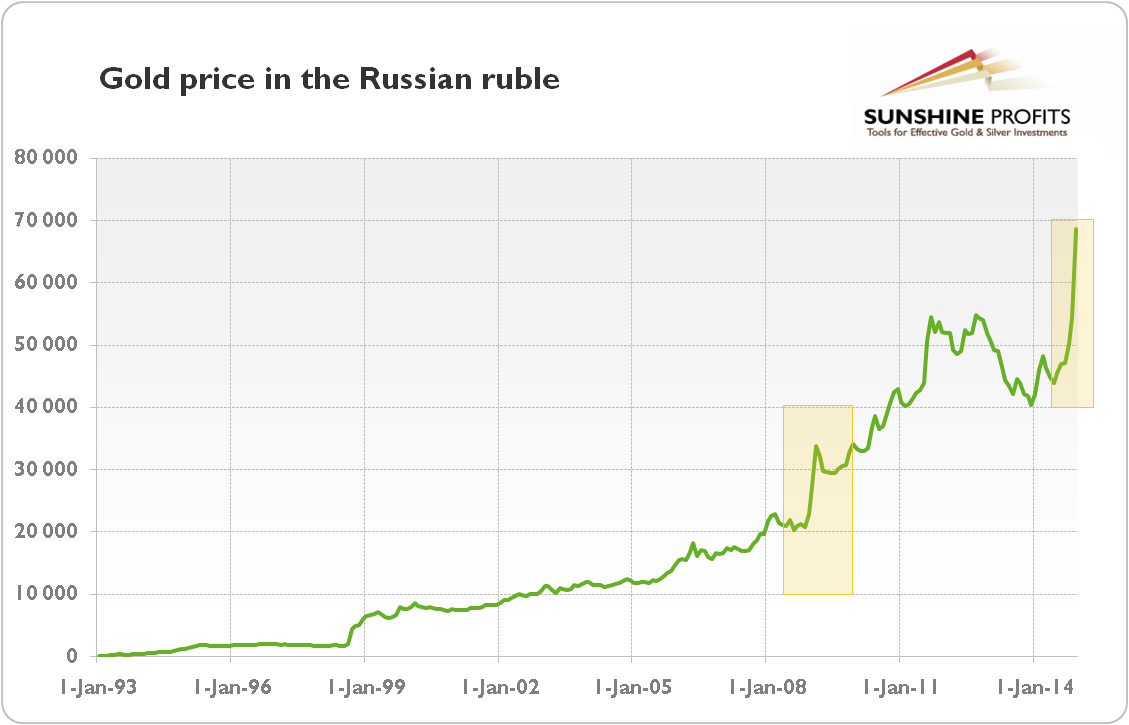What are the prospects for the Russian economy and its possible impact on global markets and gold? This year Russia is going to slide into recession (the CBR estimated that the economy will shrink 4.5 percent, if oil stays at $60/barrel). This is one that could last a while, unless there is a reverse in trends of oil prices (affected to a large extent by the greenback), and the government follows credible monetary policy, and decides to implement systemic reforms. Actually, with double-digit inflation (11.4 percent in 2014, due to its ban on Western imports and more expensive imports due to the weak ruble), Russia is heading for a severe slumpflation (inflation combined with the decrease in GDP). The banking crisis and companies defaults are coming, unless the government and the central bank bailout the bankrupts. In that case, the banking crisis will turn into a sovereign debt crisis and will entail severe inflation due to monetization of debt.
Undoubtedly, there are more unknowns regarding the government’s response. One of them is capital control. Some economists say that it is necessary to stop the fall of the ruble; however, introducing such measures will make rolling over external debt much harder for Russian firms and strengthen the position of large corporation with access to government funds.
Another question mark is geopolitics, since some analysts fear that severe economic conditions may lead to a palace coup or an even more nationalistic and aggressive stance by Putin to divert public attention from domestic problems.
The last unknown is more related to gold (geopolitical risks are generally positively correlated with gold prices; however, the importance of this relationship is often overstated). Some experts fear that the Central Bank of Russia may stop buying the yellow metal, or even start selling it to raise foreign currencies that may be needed to pay back debt. We cannot rule this out. However it would be a big distress signal (selling gold is usually considered as one of the last weapons for central banks), which proud Russians would like to avoid. And there is another, more pragmatic reason, why selling gold by the CBR is unlikely. In short, Russia’s central bank is simply forced to buy gold in order to absorb domestic production, which cannot be sold abroad due to sanctions. Numbers prove this story so far: Russia increased its gold reserves from 1150 tons in September, 2014 to 1188 tons in November, 2014.
It is not easy to assess the impact of the Russian crisis on gold prices. So far it has been positive for the yellow metal. Indeed, the gold price in rubles surged more than 70 percent in 2014, thanks to its safe-haven status in times of stress (see graph 4). Actually, the price of gold rose against all currencies in 2014, except the U.S. dollar. The future of gold prices depends to a considerable extent on the way the Russian crisis will affect the global economy. Although the bear’s sneeze has already caused cold in some post-Soviet countries, the effect on developed economies has been rather modest so far. But we should not forget that some Western banks are seriously exposed to the Russian economy. This is why shares of Austria’s Raiffeisen, Société Générale and Italy’s UniCredit dropped significantly after the recent interest rates hike by the Central Bank of Russia.
Graph 4: Gold prices in Russian rubles from 1993 to 2014

With rather small direct consequences, the indirect effects of Russian financial crisis could be much more important. As in 1998, the collapse of the biggest country in the world may trigger capital outflows from other emerging markets due to rising risk aversion among investors. Investors should consider the Russia’s troubles not only as an idiosyncratic catastrophe, but also as a symptom of broader emerging market crises. Indeed, global emerging-market funds as a whole saw outflows of $23 billion (2.6 percent) in 2014, the biggest since 2011.
As we explained in the last Market Overview, the pressure on emerging markets will support the U.S. dollar. Hence, any potential Russian contagion effect will entail the flight to U.S. Treasuries – especially now that European, not American, banks are exposed in Russia – as it happened after 1998 Russian crisis. At that time investors moved their capital from Asia and Europe to the USA. With weak European, Japanese or Chinese economies and recovery in the USA, history could repeat itself. Therefore, the gold price (in the U.S. dollar) could be under pressure on a strong greenback in the first half of 2015. However, the recent removal of the Swiss franc’s peg to the euro and ECB’s announcement of quantitative easing caused the rise in gold prices, both in the euro and U.S. dollars. After the Swiss National Bank’s action, there has been a rapid move into gold-backed ETFs, and the yellow metal has reached its highest price (around $1,300) in five months, meaning that investors recalled that gold is a safe haven and hedge against increasing volatility in the markets. It shows that gold is more sensitive to main central banks’ actions and financial situations in the Western economies than in the emerging markets.
Would you like to understand the anatomy of current financial crises? We focus on the macroeconomics and business cycles’ implications for the gold market in our monthly gold Market Overview reports; however we provide also Gold & Silver Trading Alerts for traders interested more in the short-term prospects. If you’re not ready to subscribe yet, please join our gold newsletter. It’s free and you can unsubscribe in just a few clicks.
Arkadiusz Sieron
Sunshine Profits‘ Gold News Monitor and Market Overview Editor
Gold News Monitor
Gold Trading Alerts
Gold Market Overview


